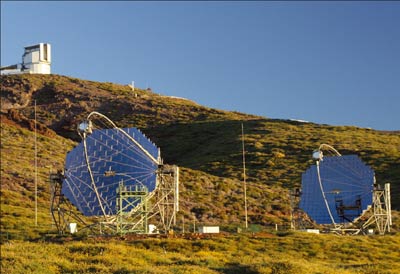
Image credit: R Wagner, MPI für Physics, Munich.
Since the Major Atmospheric Gamma Imaging Cherenkov (MAGIC) telescope began operation in 2003 it has made a host of discoveries about sources of high-energy cosmic gamma rays. This is in large part thanks to having the largest reflector in the world, a tessellated mirror with an area of 240 m2. Now the MAGIC-I telescope is being joined by a sibling, MAGIC-II, which has similar characteristics together with several improvements.
Cosmic gamma rays are important because they serve as direct messengers of distant events, unaffected by magnetic fields. Studies usually rely on satellite experiments, while ground-based Cherenkov telescopes are mainly used for the highest energies. The latter make use of the fact that charged secondary particles, generated in electromagnetic showers in the atmosphere, may emit Cherenkov radiation – photons with energies that are in the visible and UV ranges. Such photons pass through the atmosphere and are observable on the surface of the Earth using sufficiently sensitive instruments.
The MAGIC telescopes on the Canary Island of La Palma are specifically designed to detect Cherenkov radiation resulting from electromagnetic air showers generated by cosmic gamma rays. MAGIC-I was built with emphasis on the best light collection, making gamma rays accessible down to an energy threshold of 25 GeV, which is lower than for any other existing ground-based gamma-ray detector. It now provides an ideal overlap with the Large Area Telescope on the recently launched Fermi Gamma-Ray Space Telescope, which has an energy range from 20 MeV up to 300 GeV.
The new MAGIC-II telescope has the same reflector size as MAGIC-I, although it is made with larger mirrors. Its camera has been modified to increase spatial resolution and sensitivity by hosting a larger number of photomultipliers of higher efficiency. It also incorporates a new read-out system. The new system’s gain in sensitivity will be between a factor of two and a factor of three compared with MAGIC-I, depending on energy. A lower energy threshold means a higher sensitivity to special phenomena – and a deeper view into the universe. It was characteristics such as these that in 2008 enabled MAGIC-I to discover the most distant very-high-energy gamma sources, including the supermassive black hole 3C279, at a record distance of 6000 million light-years – an observation that questions theories on the transparency of the universe to gamma rays (MAGIC Collaboration 2008a). In addition, MAGIC-I revealed pulsed gamma-rays above 25 GeV emanating from the Crab pulsar; this is the highest energy pulsed emission so far detected (MAGIC Collaboration 2008b).
The new MAGIC-II telescope will couple a low threshold with higher sensitivity and resolution, as well as improve further the view of the highest energy phenomena in the universe. A “first-light” ceremony is to take place on 24–25 April at the site on La Palma.
Further reading
For more information about MAGIC, see http://magic.mppmu.mpg.de.
MAGIC Collaboration 2008a Science 320 1752.
MAGIC Collaboration 2008b Science 322 1221.








